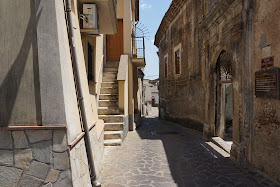 |
| Castrovillari (Calabria), Italy. Street sign which maintains the name of the pre-1511 Jewish "Giudeca" (quarter). Photo: Samuel Gruber 2019. |
 |
| Castrovillari (Calabria), Italy. The pre-1511 Jewish "Giudeca" (quarter). Photo: Samuel Gruber 2019. |
 |
| Castrovillari (Calabria), Italy. Adjacent to the pre-1511 Jewish "Giudeca" (quarter). Photo: Samuel Gruber 2019. |
by Samuel D. Gruber
Calabria, the region of Italy that extends from the instep of the peninsula to the toe, and from the mountains to the sea, has a long and rich Jewish history-- from the period of ancient Rome through the early 16th century when Jews were expelled after the territory came under Spanish rule. Despite an absence of nearly half a millennium, echoes of the Jews can still be fond in place names throughout Calabria documented by Sonia Vivaqua; such as Monte Giudei, Casale Giudeo, Acqua Judia, Judio Sottano, Judio Suprano, and other designations remembered long after the passing of the Jews.
This summer I was in Calabria for a week with family members, not especially seeking out Jewish remnants. Still, we took a short trip from where we were staying to the town of Castrovillari to see the remnants of the Jewish quarter of the old town, an area still remembered in the street names indicated by numerous street signs.
 |
| Castrovillari (Calabria), Italy. Street sign of an alley off the main Giudeca, which maintains the name of the pre-1511 Jewish quarter. Photo: Samuel Gruber 2019. |
 |
| Castrovillari (Calabria), Italy. An alley off the main Giudeca, which maintains the name of the pre-1511 Jewish quarter. Photo: Samuel Gruber 2019. |
 |
| Castrovillari (Calabria), Italy. Street sign which maintains the name of the pre-1511 Jewish "Giudeca" (quarter). Photo: Samuel Gruber 2019. |
 |
| Castrovillari (Calabria), Italy. The pre-1511 Jewish "Giudeca" (quarter). On the right is the entrance to the Palazzo Salituri alla Giudeca. Photo: Samuel Gruber 2019. |
 |
| Castrovillari (Calabria), Italy. Off the main Giudeca. Photo: Samuel Gruber 2019. |
It was King Ferdinand of Aragon (and his wife Isabella) who expelled the Jews from Spain, and then in the early 1500s also from the Spanish territories in Southern Italy, where the Aragonese has taken over the Kingdom of Naples and asserted control over the Dukes of Calabria. Beginning around 1460 they constructed a series of castles to control internal dissent and as protection against Mediterranean pirates. In Castrovillari the new castle was built on the site of an older Swabian fortress and was completed in 1490 (as is explained in an inscription over the entrance) at the behest of King Ferdinand of Aragon. The Calabrian castles, all of which have similar or identical inscriptions, were designed according to the precepts of the famed architect-engineer Francesco di Giorgio Martini, who worked at the court of Naples in the 1490.
Though Francesco di Giorgio is better remembered by art historians for his work in Siena, Milan, and elsewhere, his legacy across Southern Italy is fearsome. From 1495 to 1995 the Castle was used as a prison, and the building has a long, dark and bloody history. It was long known as a terrible center of torture and death. Restored in 2011, it is now it is a concert and exhibition venue. For more on Franceso di Giorgio's military architecture in Southern Italy see Michael S. A. Dechert's article, "The Military Architecture of Francesco di Giorgio in Southern Italy," in the Journal of the Society of Architectural Historians, Vol. 49, No. 2 (Jun., 1990), pp. 161-18.
 |
| Castrovillari (Calabria), Italy. The Aragonese Castle, completed in 1490, long a place of torture and death, but now a center for music and art. Photo: Samuel Gruber 2019. |
 |
| Castrovillari (Calabria), Italy. The Aragonese Castle, completed in 1490. Photo: Samuel Gruber 2019. |
A fascinating and sad reminder of more recent history is a memorial to Castrovillari civilians who were killed in an Allied bombing raid on Aug 24-25, 1943, several weeks before the main invasion of Southern Italy (Allied forces would eventually enter Castrovillari on September 12, 1943 when Montgomery's British XIII Corps reached the town).
The monument consists of one standing wall of a building across from the facade of the Church of San Giuliano, on the edge of the Giudeca. A simple plaque lists the names and ages of those killed in the bombardment.
 |
| Castrovillari (Calabria), Italy. Memorial to Victims of Allied Bombing near San Giuliano, of August 24-25, 1943. Photo: Samuel Gruber 2019. |
 |
| Castrovillari (Calabria), Italy. Memorial to Victims of Allied Bombing near San Giuliano, of August 24-25, 1943. Photo: Samuel Gruber 2019. |
 |
| Castrovillari (Calabria), Italy. Memorial to Victims of Allied Bombing near San Giuliano, of August 24-25, 1943. Photo: Samuel Gruber 2019. |
Also mentioned in this post is the 1994 paper by Sonia Vivaqua “Gli ebrei in Calabria,” in Architettura Judaica in Italia: ebraismo,
sito, memoria dei luoghi (Flaccovio Editore, Palermo, 1994), 257-268. Rabbi Barbara Aiello has been active in bringing contemporary Jewish practice to Calabria, but I have not seen evidence of much associated deep history. Calabria - and much of the Italian south - is still wide open for serious researchers.

No comments:
Post a Comment